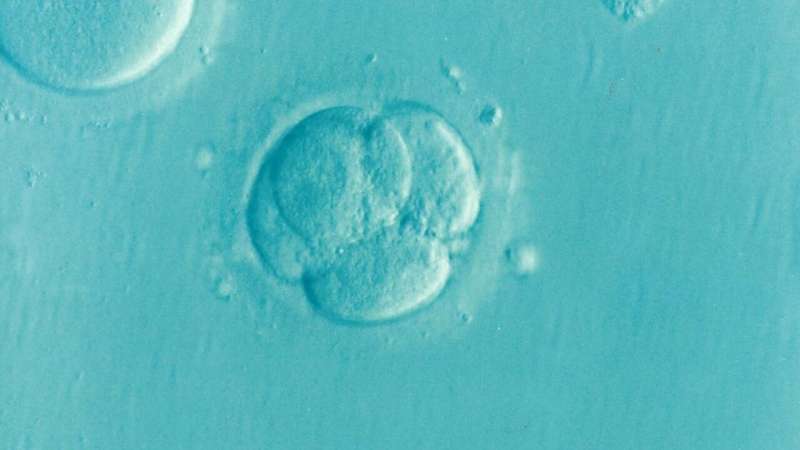How did humans evolve such rotten genetics?

Gaby Clark
scientific editor

Andrew Zinin
lead editor

To Shakespeare's Hamlet, we humans are "the paragon of animals." But recent advances in genetics are suggesting that humans are far from being evolution's greatest achievement.
For example, humans have an exceptionally high proportion of fertilized eggs that have the wrong number of chromosomes and one of the highest rates of harmful genetic mutation.
In my new book, "," I suggest that two features of our biology explain why our genetics are in such a poor state. First, we evolved a lot of our human features when our populations were small, and second, we feed our young across a placenta.
Our reproduction is for both mother and embryo. For every child born, never made it.
have chromosomal problems. For older mothers, these embryos tend to have chromosomes due to problems in the process of making eggs with just one copy of each chromosome. Most chromosomally abnormal embryos don't make it to week six so are never a .
About 15% of recognized pregnancies , usually before week 12, rising to 65% in women over 40. of miscarriages are because of chromosomal issues.
Other mammals have similar chromosome-number problems but with an error rate of about . Cows should have 30 chromosomes in sperm or egg but about 30% of their fertilized eggs have .
Humans with 23 chromosomes should have about 23% of fertilized eggs with the wrong number of chromosomes, but our rate is higher because we presently reproduce late and chromosomal errors escalate with maternal age.
Survive that, then gestational diabetes and high blood pressure issues await, most notably pre-eclampsia, potentially lethal to , affecting about 5% of pregnancies. It is unique to humans.
Historically, up until about 1800, childbirth was remarkably dangerous with about 1% risk, largely owing to pre-eclampsia, bleeding and infection. In by contrast, despite offspring also having a large head, maternal mortality isn't seen. Advances in maternal care have seen current UK maternal mortality rates plummet to .
Many of these problems are contingent on the placenta. Compare us to a kiwi bird that loads its large egg with resources and sits on it, even if it is dead: time and energy are wasted. In mammals, if the embryo is not viable, the mother may not even know she had conceived.
The high rate of chromosomal issues in our early embryos is a connected to the fact that early termination of a pregnancy lessens the costs, meaning less time wasted holding onto a dead embryo and not giving up the resources that are needed for a viable embryo to grow into a baby.
But reduced costs are to explain why chromosomal problems are so common in mammals.
During the process of making a fertilizable egg with one copy of each chromosome, a sister cell is produced, called the polar body. It's there to discard half of the chromosomes. It can "pay" for a chromosome to not go to the polar body when it should instead stay behind in the soon to be fertilized egg.
It forces redirection of resources to viable offspring. This can chromosomal errors are mostly maternal and why, given their lack of ability to redirect saved energy, other vertebrates don't seem to have .
Our problems with are a consequence of fetuses releasing chemicals from the placenta into the mother's blood to keep . The problems with pre-eclampsia are associated with malfunctioning placentas, in part owing to of the fetus.
Regular unprotected sex can protect women by helping the mother become used to paternal proteins. The fact that pre-eclampsia is may be related to our exceptionally invasive placenta that burrows deep into the uterine lining, possibly required to build our unusually large brains.
Our other peculiarities are predicted by the most influential evolutionary theory of the last 50 years, the . It states that natural selection is less efficient when a species has few individuals.
A slightly harmful mutation can be removed from a population if that population is large but can increase in frequency, by chance, if the population is small. Most human-specific features evolved when our population size was around in Africa prior to its recent (last 20,000 years) expansion. Minuscule compared to, for example, bacterial populations.
This we have such a . The main job of DNA is to give instructions to our cells about how to make the proteins vital for life.
That is done by just 1% of our DNA but by 85% of that of our gut-dwelling bacteria Escherichia coli. Some of our DNA is required for other reasons, such as controlling which genes get activated and when. Yet of our DNA shows any signs of being useful.
If you have a small population size, you also have more problems stopping genetical errors like mutations. Although DNA mutations can be beneficial, they are more commonly a curse. They are the basis of genetic diseases, be they complex (such as Crohn's disease and predispositions to cancer), or owing to single gene effects (like cystic fibrosis and Huntington's disease).
We have one of the of all species. Other species with massive populations have mutation rates , another prediction of the .
A consequence of our high mutation rate is that around a "rare" genetic disease.
Modern medicine may help cure our many ailments, but if we can't do anything about our mutation rate, we will still get ill.
Provided by The Conversation
This article is republished from The Conversation under a Creative Commons license. Read the original article.![]()
















